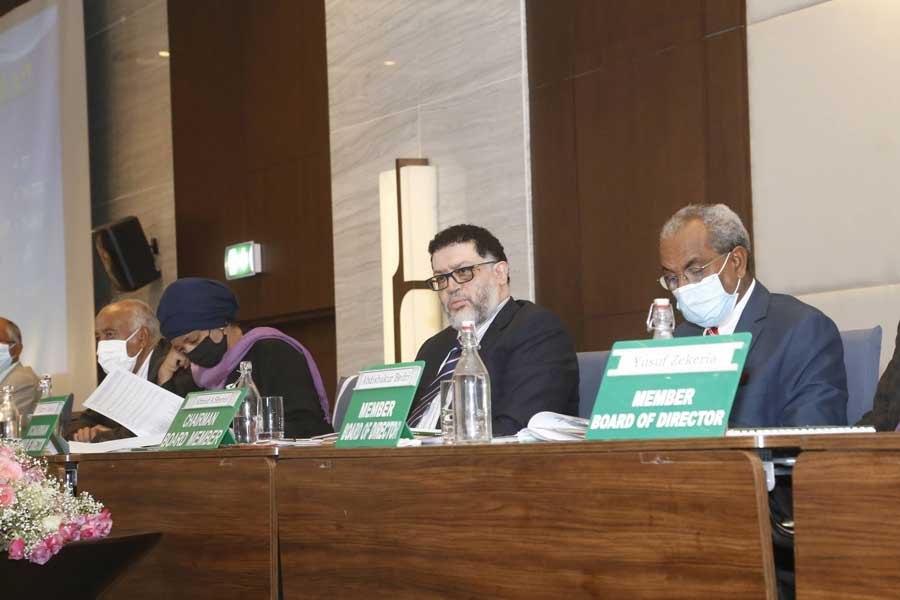
Commentaries | Feb 16,2019
Feb 2 , 2019
By FASIKA TADESSE ( FORTUNE STAFF WRITER )
Political uncertainty and the severe foreign exchange crunch in the economy has dragged down the growth rate of Nib Bank during the last fiscal year.
The 19-year-old Nib did, however, manage to increase its profit by four percent to 514.85 million Br. This growth rate is much lower than the previous year, which stood at 45pc.
This, coupled with a 16pc crease in paid-up capital to bring the figure to 2.08 billion Br, led the firm’s earnings per share to slump by 15 Br to 134 Br.
The period can at best be characterised by formidable challenges that the banking sector faced, according to Woldetensai Woldegiorgis, board chairperson of the Bank.
Sluggish growth in the export sector, acute shortage of foreign currency that severely affected import activities and social and political unrest that had a detrimental effect on the smooth functioning of daily business operations are a few of the challenges, according to Woldetensai.
Detailed observation of the profit and loss account of the bank shows that Nib reported mixed results in generating income.
It performed well in financial intermediation operations. Interest on loans, advances and bonds of the National Bank of Ethiopia increased by 43pc to 2.07 billion Br, while fees and commissions increased by only a percentage point to 319.82 million Br.
What the Bank earned last year from foreign exchange dealing slumped by half, however, reporting only 46.42 million Br.
“The decline of income from forex dealings is shocking,” commented Abdulemanan Mohammed, a financial statement analyst with a decade and a half of experience. “This area of business needs thorough attention.”
Kibru Fondja, the president of the Bank, attributes stringent requirements by the central bank in forex allocation coupled with the macroeconomic problems of the country were the primary reasons for the disappointing result.
The central bank’s direction, which compels all banks to provide forex for anyone who applies for foreign currencies, has severely affected the bank, according to the president.
“We lost many of our customers, as we couldn't provide them with forex while trying to allocate foreign currency to other applicants,” Kibru told Fortune. “On top that, all of the banks have been scrambling for the forex that comes into the country.”
The total expenses at Nib have also increased by 46pc to 1.8 billion Br. Interest expense went up by 65pc, salaries and benefits increased by 38pc and other operating expenses increased by 18pc.
“The bank mobilised a huge deposit last year with a higher interest rate,” said Kibru. “This made our expense on interest skyrocket.”
At Nib, ongoing projects consumed a large chunk of cash.
"To prevent the operations from this effect, the Bank aggressively mobilised large deposits," Kibru told Fortune.
Last year the Bank invested 680 million Br in acquiring a building at Arat Kilo, and has been constructing a 12-storey building in Hawassa and a five-storey building in Hosana. It is also building its headquarters in the financial district in Lideta.
Provision for loans and other assets impairment increased to 47.6 million Br from 26.2 million Br.
"Despite the increase, the amount is still reasonable," commented Abdulmenan.
The total assets of Nib expanded by 26pc to 26.69 billion Br. The Bank disbursed loans and advances totaling 13.5 billion Br, an increase of 26pc; and mobilised deposits of 21.62 billion Br, an increase of 31pc.
The private bank disbursed a total of 67.16 billion Br in loans and advances in the last fiscal year while mobilising 139.9 billion Br resources.
Nib’s loan-to-deposits ratio went down by two percentage points to 62pc, lower than the industry average of 67pc in 2017.
“Nib needs to exert some efforts to achieve at least the industry average,” Abdulemnan suggested.
Nib has invested 6.1 billion Br in the National Bank’s five-year bond, representing 23pc of the total assets and 28.4pc of deposits at the Bank. These proportions are slightly higher than the industry average of 21pc and 27pc, respectively.
“This might have been due to disbursement of loans and advances with high turnover,” said Abdulmenan.
Liquidity ratios reveal that the liquidity level of Nib has increased in value terms but declined in relative terms.
The amount of cash and bank balances held by Nib has increased by 18pc to 3.88 billion Br.
Total cash and bank balances to total assets dropped by a percentage point to 15pc, and total cash and bank balances to total liabilities also fell to 16.6pc from 17.9pc.
Nib still had outstanding borrowing of 203.7 million Br, while the private banking industry has a total of 182.1 billion Br in outstanding credit.
The bank has a capital adequacy ratio (CAR) of 22.6pc. This means that it is highly capitalised.
"So it should use its capital efficiently," recommended Abdulmenan.
During the latest general assembly of the bank, shareholders agreed to bump the paid-up capital of the firm to five billion Birr.
PUBLISHED ON
Feb 02,2019 [ VOL
19 , NO
979]

Commentaries | Feb 16,2019

Radar | Jul 30,2022

Radar | Apr 19,2025

Radar | Feb 05,2022

Fortune News | May 23,2020

Fortune News | Mar 13,2021

Commentaries | Jan 31,2021

News Analysis | Apr 19,2025

Sunday with Eden | Feb 22,2020

Fortune News | Feb 16,2019

Dec 22 , 2024 . By TIZITA SHEWAFERAW
Charged with transforming colossal state-owned enterprises into modern and competitiv...

Aug 18 , 2024 . By AKSAH ITALO
Although predictable Yonas Zerihun's job in the ride-hailing service is not immune to...

Jul 28 , 2024 . By TIZITA SHEWAFERAW
Unhabitual, perhaps too many, Samuel Gebreyohannes, 38, used to occasionally enjoy a couple of beers at breakfast. However, he recently swit...

Jul 13 , 2024 . By AKSAH ITALO
Investors who rely on tractors, trucks, and field vehicles for commuting, transporting commodities, and f...

Oct 25 , 2025
The regulatory machinery is on overdrive. In only two years, no fewer than 35 new pro...

Oct 18 , 2025
The political establishment, notably the ruling party and its top brass, has become p...

Oct 11 , 2025
Ladislas Farago, a roving Associated Press (AP) correspondent, arrived in Ethiopia in...

Oct 4 , 2025
Eyob Tekalegn (PhD) had been in the Governor's chair for only weeks when, on Septembe...